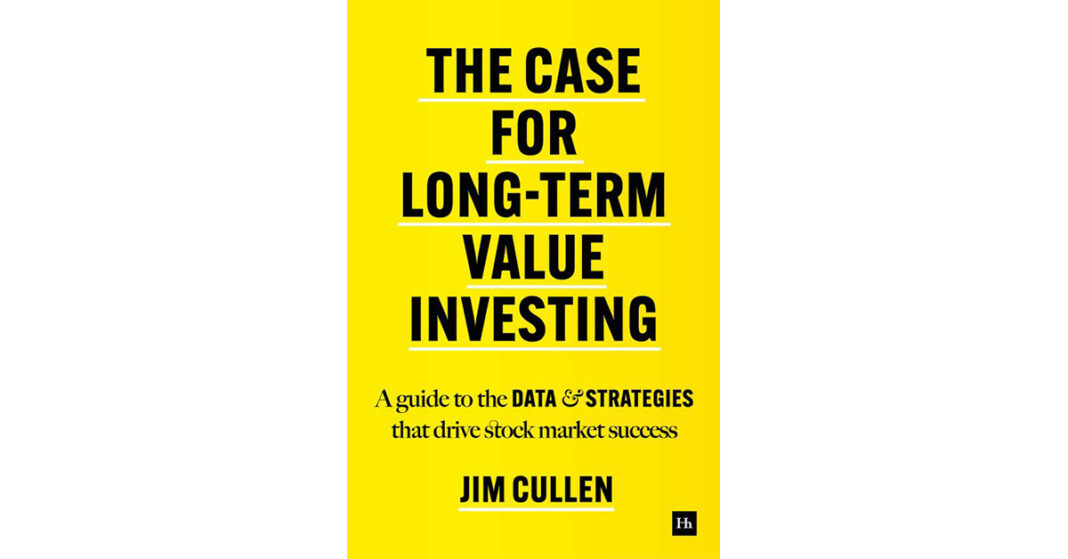The Case for Long-Term Value Investing: A Guide to the Data and Strategies That Drive Stock Market Success. 2022. Jim Cullen. Harriman House.
The bright yellow dustjacket of Jim Cullen’s The Case for Long-Term Value Investing suggests either caution or sunshine. On the cautious side, investors acknowledge that market-exposed assets lost value in 2022 and question whether they ought to liquidate and run for the hills or follow a discipline that will fulfill investment objectives over the long haul. On the sunny side, Cullen proposes a discipline that should produce satisfactory risk- and inflation-adjusted returns over a five-year period, if not much longer.
Cullen is a rare author among contemporary active asset managers, with a career of 60 years in investment management. His lifetime provides a scale of experience that few have, and he generously shares it here, supported by analysis, backtesting, and memorable stories of investments gone well or awry. The simple style of presenting the value strategy and how to apply it in any type of market will convert many who doubt its success into believers.
What is long-term value investing? It is clear that Cullen defines “long term” as at least five years. Ignoring that perspective highlights numerous short-term melt-up markets that leave value stocks in the dust. Examining longer periods reveals a far different picture. Cullen presents abundant data covering very long stretches of time, generally concluding in 2020. Sticking to long-term investment goals rather than chasing momentum for fear of missing out leads to higher performance than growth investing provides. The rolling five-year basis that Cullen emphasizes smooths performance and sheds light on the growth/value debate. He makes a compelling case for a long and steep downside for growth stocks when they ultimately correct.
The author’s examination of the lowest P/Es (the bottom 20%) and the highest dividend yields (the top 20%) also considers growth of earnings and dividends over time, encouraging focus on the stock rather than the stock market. Emphasis on the lowest price-to-book ratios further boosts the case he makes for value. Many of us question the valuations of assets reflected in book value, with an extreme example being bank and financial assets before and during the financial crisis of 2008–2009. Outside of traditional industries, such as airlines, metals, and energy, and acknowledging the dominance of the tech era, with its high or non-meaningful price-to-book ratios, low price-to-book can be an effective screening tool. The lowest price-to-book ratios of the S&P 500 Index performed quite nicely alongside the lowest P/Es and the highest dividend yielders, except in individual years during bubbles or melt-ups. The graphic evidence is presented convincingly in a chart depicting “The Three Disciplines” and how they performed in each year from 1968 to 2020.
As astute as Cullen is in convincing us of the realities of value investing, he also provides thoughtful analysis of inflection points in markets based on such critical considerations as government, corporate, and individual debt levels; the level and direction of interest rates; and consumer confidence. In reviewing the current data, readers may come away assured that the current bear market might not prove long lasting, especially for those who focus on valuations, earnings, and dividend growth and stay the course.
Cullen considers market timing the silent killer of investment performance, especially in the case of “strategic” shifts to cash and attempts to improve returns. The shifts to cash that he addresses are those that last for a month or more. Just a few moves out of the market can result in substantial investment underperformance, especially in frightening times of extreme illiquidity and deep recession.
Two other points require mention. Value investing is applicable to all capitalizations and geographic areas, including emerging markets. Small-cap value has done remarkably well over the long term owing to the frequency of takeovers. Covered call writing can usefully come into play, considering the sharp drop in bond yields occasioned by a 30-year bond bull market, even as interest rates creep up. Cullen shares a covered call writing strategy for tax-exempt investment accounts that enhances portfolio performance, as opposed to investing in selected bonds solely for income.
A section titled “Getting Started — New Investors” occupies just a few pages before the book’s final note. I found it to be hugely entertaining and educational. The author highlights saving, investing, and the beauty of compound interest. Most readers will find it startling that he recommends annual investment contributions until age 80! My suggestion to the new investor would be to aim for this long contribution period but if that is not possible, to attempt at least to reduce expenses by the amount one cannot continue to contribute to investments.
After reading his well-presented case for long-term value investing, testing for additional periods beyond those published, and reviewing recent economic data with a critical eye as Cullen does, I agree with him that this is a book for all investors. This is so even though analytically inclined investors will likely go beyond his stated criteria for security selection — that is, the lowest P/Es and price-to-books coupled with the highest dividend yields.
If you liked this post, don’t forget to subscribe to the Enterprising Investor.
All posts are the opinion of the author. As such, they should not be construed as investment advice, nor do the opinions expressed necessarily reflect the views of CFA Institute or the author’s employer.
Professional Learning for CFA Institute Members
CFA Institute members are empowered to self-determine and self-report professional learning (PL) credits earned, including content on Enterprising Investor. Members can record credits easily using their online PL tracker.


